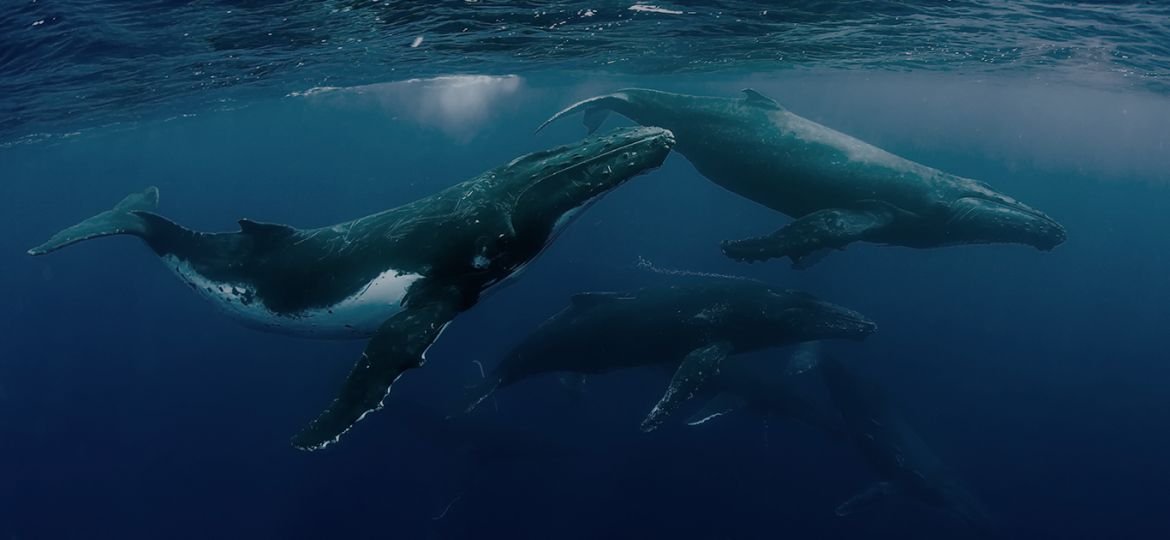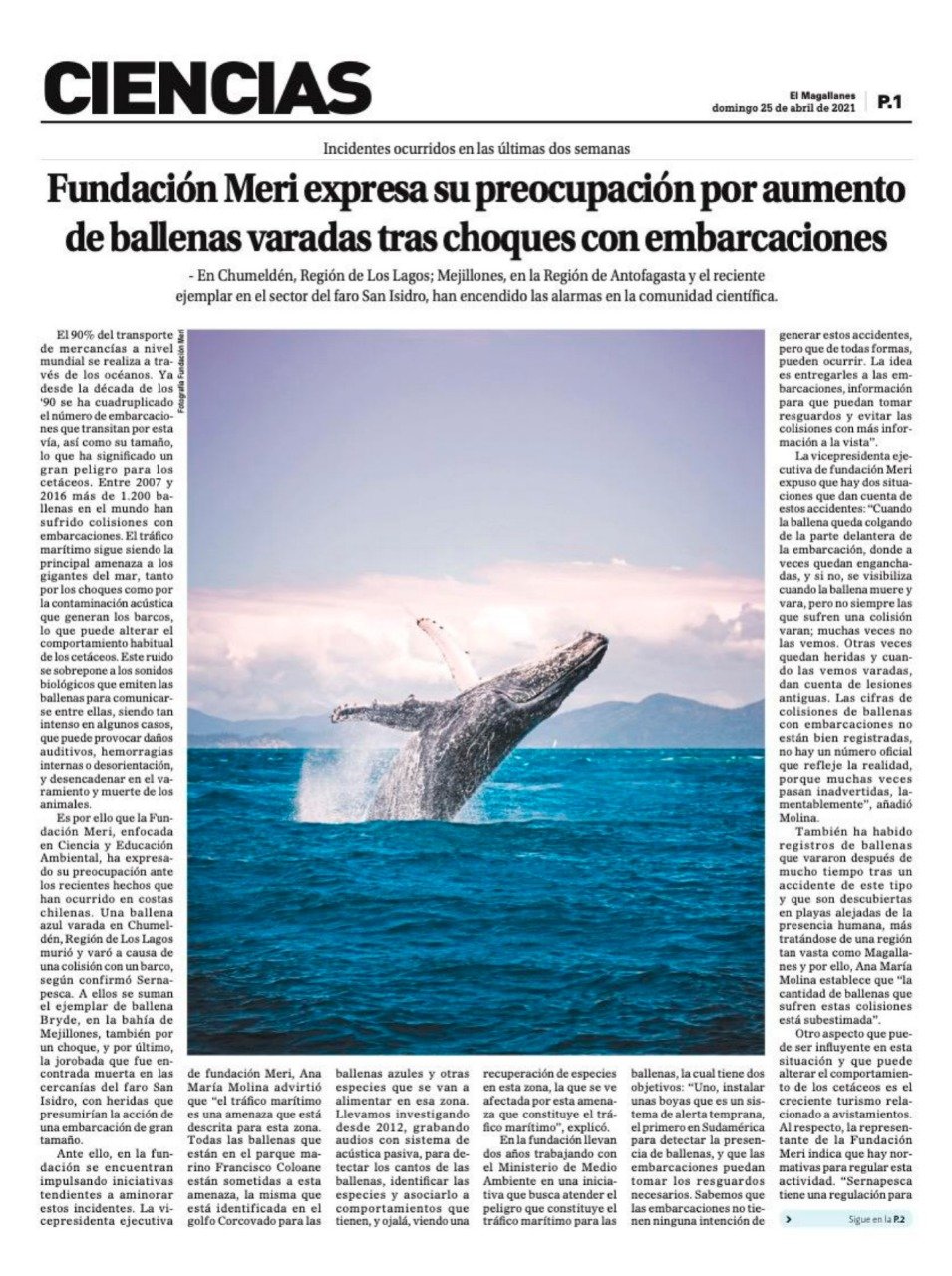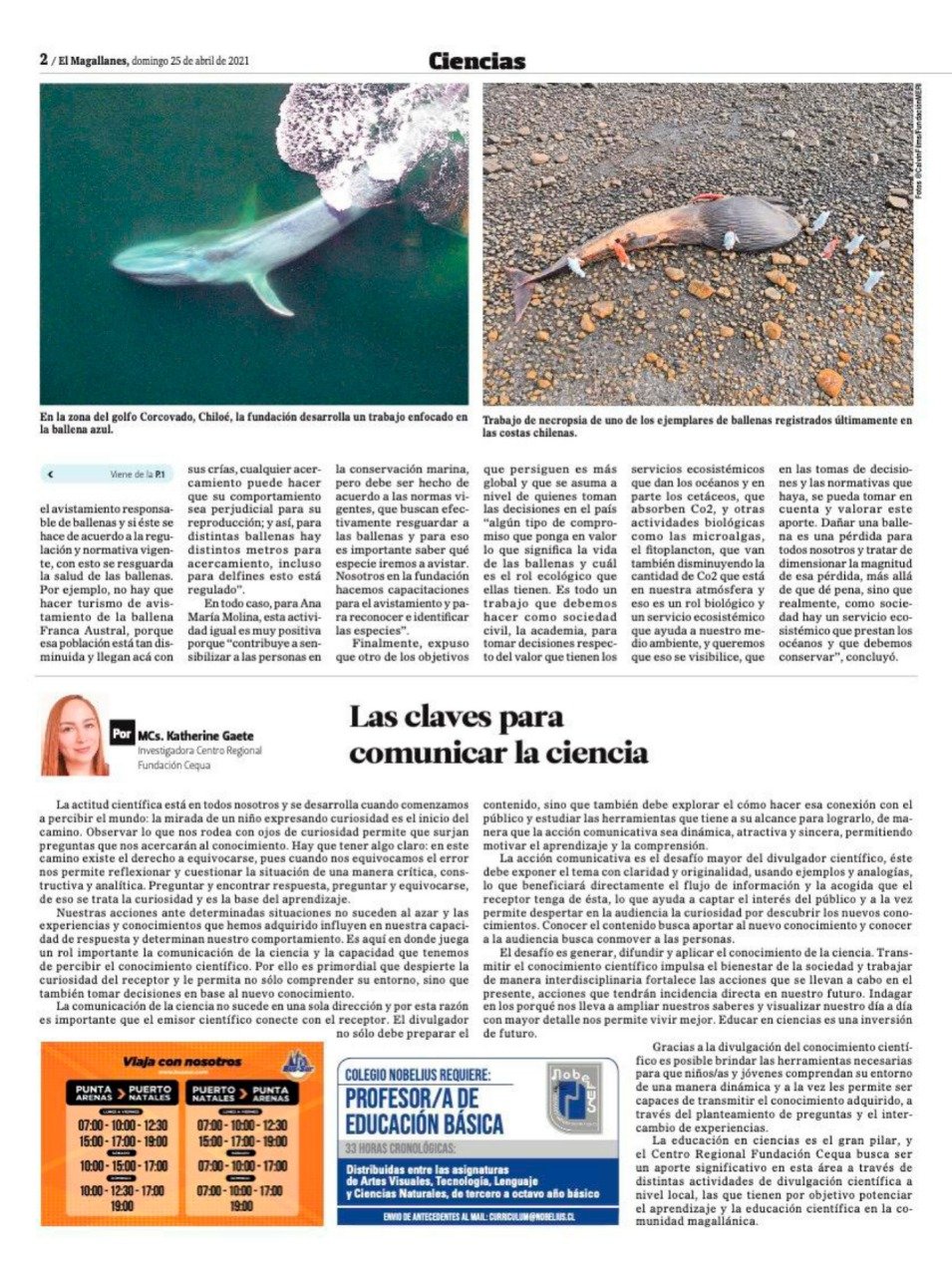
The strandings in Chumeldén, Los Lagos Region; Mejillones, in the Antofagasta Region and the recent specimen stranded in the San Isidro lighthouse area have set off alarms in the scientific community.
90% of the world’s freight is transported across the oceans. Since the 1990s, the number of vessels has quadrupled, and ships have also grown in size, which has resulted in great danger for the cetaceans. Between 2007 and 2016, more than 1,200 whales in the world have collided with vessels. Maritime traffic continues to be the main threat to the giants of the sea, both because of ship strikes and noise pollution created by vessels, which can alter the cetaceans’ usual behavior. This noise is superimposed on the biological sounds that whales emit to communicate with each other, being so intense in some cases that it can cause hearing damage, internal hemorrhaging or disorientation, and can lead to stranding and even death of the animals.
That is why the MERI Foundation, focused on Science and Environmental Education, has expressed its concern about the recent events that have taken place on Chilean coasts. A blue whale stranded in Chumeldén, Los Lagos Region, was beached and died due to a collision with a ship, as confirmed by Sernapesca. In addition, a Bryde’s whale was found dead in Mejillones Bay, also due to ship strike, and finally, a Humpback whale was found dead near the San Isidro lighthouse, with wounds that suggested contact with a large vessel.
In view of this, the foundation is promoting initiatives to reduce these incidents. The Executive Vice President of the MERI Foundation, Ana María Molina, warned that “maritime traffic is a threat that has been described for this area. All whales in the Francisco Coloane Marine Park are subject to this threat, the same threat that has been identified in the Corcovado Gulf for blue whales and other species that feed in that area. We have been researching since 2012, recording audios with a passive acoustic system to detect the whales’ songs, identify the species and associate it with their behavior, and hopefully see a recovery of species in this area, which is affected by the threat posed by maritime traffic,” she explained.
The foundation has been working with the Ministry of the Environment for two years on an initiative that seeks to address the danger to whales posed by maritime traffic, which has two objectives: “One is to install buoys, which is an early warning system, the first in South America to detect the presence of whales, so that vessels can take the necessary precautions. We know that vessels do not intend to cause these accidents, but they can still happen. The idea is to provide the vessels with information so that they can take precautions and avoid collisions with more information at hand.”
The Executive Vice President of the MERI foundation explained that there are two situations that account for these accidents: “You can see the whale is hanging from the front of the boat, where they sometimes become lodged, or when the whale dies and breaches. However, not all whales that suffer a collision wash ashore; there are many that we do not see. Other times they are injured and when we see them stranded, they show old injuries. The number of ship strikes is not well recorded, there is no official number that reflects the reality, because many times they go unnoticed, unfortunately,” added Molina.
There have also been records of whales that were stranded for a long time after being struck by a ship. They are discovered on beaches far from any human presence, especially in a region as vast as Magallanes, and for this reason, Ana María Molina stated that “the number of whales that suffer these collisions is underestimated.”
Another aspect that may be influential in this situation and that may alter the behavior of cetaceans is the growing tourism related to whale watching. In this regard, the representative of the MERI Foundation indicated that there are regulations for this activity. “Sernapesca has regulations for responsible whale watching. When this is done according to the current regulations and norms, this protects the health of the whales. For example, we should not engage in whale watching of the Southern Right whale, because that population is very diminished and they come here with their calves, and any approach can cause their behavior to be detrimental to reproduction. For different whales there are different recommended meters of distance to maintain, even for dolphins this is regulated.”
In any case, for Ana María Molina, this activity is still very positive because “it helps to raise awareness of marine conservation, but it must be done in accordance with current regulations, which effectively seek to protect the whales and for that it is important to know what species we are going to see. Our foundation provides training in sighting, species recognition, and identification.”
Finally, she stated that another of the objectives they are pursuing is more global and that the idea is that the country’s decision makers “make some type of commitment that values the significance of whale life and the ecological role they play. It is a work that we must do as civil society and in academia, to make decisions regarding the value of the ecosystem services provided by both oceans and cetaceans. They absorb CO2 and provide other biological activities, such as microalgae and phytoplankton, which also reduce the amount of CO2 that is in our atmosphere. This is a biological role and an ecosystemic service that helps our environment. We want to make this visible, so that this contribution can be taken into account and valued in decision-making and regulations. When a whale is harmed, we all lose and we must try to measure the magnitude of this loss, beyond the fact that it is a pity, but really, as a society, there is an ecosystemic service provided by the oceans that we must conserve,” she concluded.
Source: La Prensa Austral



